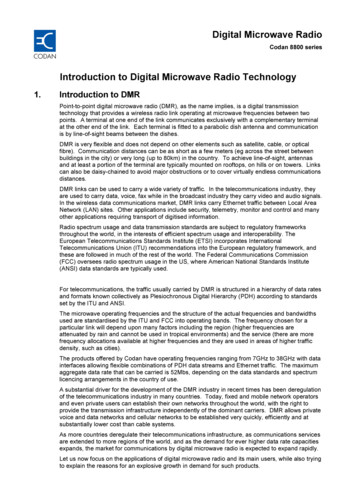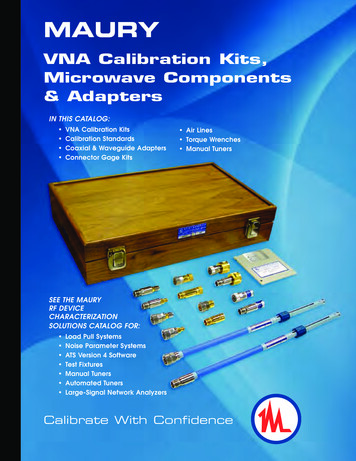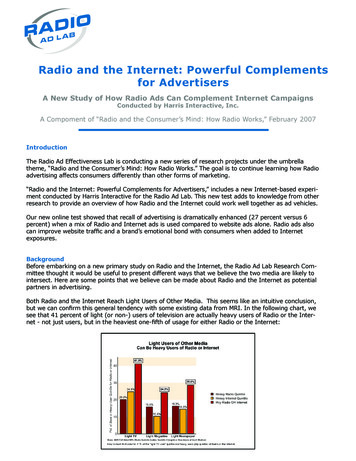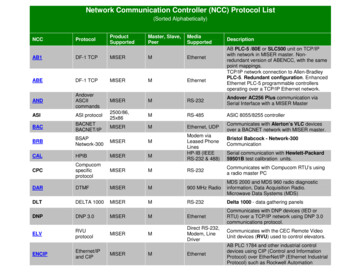
Transcription
Digital Microwave RadioCodan 8800 seriesIntroduction to Digital Microwave Radio Technology1.Introduction to DMRPoint-to-point digital microwave radio (DMR), as the name implies, is a digital transmissiontechnology that provides a wireless radio link operating at microwave frequencies between twopoints. A terminal at one end of the link communicates exclusively with a complementary terminalat the other end of the link. Each terminal is fitted to a parabolic dish antenna and communicationis by line-of-sight beams between the dishes.DMR is very flexible and does not depend on other elements such as satellite, cable, or opticalfibre). Communication distances can be as short as a few meters (eg across the street betweenbuildings in the city) or very long (up to 80km) in the country. To achieve line-of-sight, antennasand at least a portion of the terminal are typically mounted on rooftops, on hills or on towers. Linkscan also be daisy-chained to avoid major obstructions or to cover virtually endless communicationsdistances.DMR links can be used to carry a wide variety of traffic. In the telecommunications industry, theyare used to carry data, voice, fax while in the broadcast industry they carry video and audio signals.In the wireless data communications market, DMR links carry Ethernet traffic between Local AreaNetwork (LAN) sites. Other applications include security, telemetry, monitor and control and manyother applications requiring transport of digitised information.Radio spectrum usage and data transmission standards are subject to regulatory frameworksthroughout the world, in the interests of efficient spectrum usage and interoperability. TheEuropean Telecommunications Standards Institute (ETSI) incorporates InternationalTelecommunications Union (ITU) recommendations into the European regulatory framework, andthese are followed in much of the rest of the world. The Federal Communications Commission(FCC) oversees radio spectrum usage in the US, where American National Standards Institute(ANSI) data standards are typically used.For telecommunications, the traffic usually carried by DMR is structured in a hierarchy of data ratesand formats known collectively as Plesiochronous Digital Hierarchy (PDH) according to standardsset by the ITU and ANSI.The microwave operating frequencies and the structure of the actual frequencies and bandwidthsused are standardised by the ITU and FCC into operating bands. The frequency chosen for aparticular link will depend upon many factors including the region (higher frequencies areattenuated by rain and cannot be used in tropical environments) and the service (there are morefrequency allocations available at higher frequencies and they are used in areas of higher trafficdensity, such as cities).The products offered by Codan have operating frequencies ranging from 7GHz to 38GHz with datainterfaces allowing flexible combinations of PDH data streams and Ethernet traffic. The maximumaggregate data rate that can be carried is 52Mbs, depending on the data standards and spectrumlicencing arrangements in the country of use.A substantial driver for the development of the DMR industry in recent times has been deregulationof the telecommunications industry in many countries. Today, fixed and mobile network operatorsand even private users can establish their own networks throughout the world, with the right toprovide the transmission infrastructure independently of the dominant carriers. DMR allows privatevoice and data networks and cellular networks to be established very quickly, efficiently and atsubstantially lower cost than cable systems.As more countries deregulate their telecommunications infrastructure, as communications servicesare extended to more regions of the world, and as the demand for ever higher data rate capacitiesexpands, the market for communications by digital microwave radio is expected to expand rapidly.Let us now focus on the applications of digital microwave radio and its main users, while also tryingto explain the reasons for an explosive growth in demand for such products.
Digital Microwave RadioCodan 8800 seriesWhat is DMR used for?1.1.Cellular ApplicationsThe greatest growth area for the use of digital microwave radio is currently associated with theemergence of new cellular mobile operators as part of a liberalized telecommunicationsenvironment. It is normal for newly licensed operators to be granted the rights to self-provide thetransmission infrastructure.It is also the trend that the terms of such competitive licenses commit the operators to challengingoperational obligations, i.e. to provide service throughout a certain percentage of the country withinan ambitious time frame. Furthermore, operators need to provide service at the earliest opportunityto realize revenues in line with their business plans.Faced with this scenario, mobile operators are very conscious of the advantages of digitalmicrowave radio. The speed of installation and flexibility to upgrade in line with networkrequirements has meant that almost all mobile operators who are independent from the PTTorganizations and have the right to self-provide have chosen digital microwave radio as theinterconnect solution for base stations.Figure 1 – GSM Application
Digital Microwave RadioCodan 8800 series1.2.PTT fixed network applicationsNewly licensed competitive operators are not the only users of microwave radio, and a number offactors are leading to a growing demand from incumbent fixed network operators. With the growingliberalization in telecommunications, PTT’s are now finding themselves operating in a morecompetitive environment. As a result, users are being offered greater quality of service and learningthat they can demand more from service operators. Time scale for provision of service is a majordifferentiator for a PTT operator wishing to offer competitive services.Because of the flexibility of microwave radio and the ease and speed of installation, these productsare increasingly finding their way into PTT access or back-haul networks. Elsewhere, in manydeveloping markets, operators who wish to provide international telephone and data services tocustomers are utilizing microwave direct from exchanges to the customer premises in order tobypass local networks that are often inadequate.Utilizing microwave radio as an access medium direct to a customer's premises has been commonfor a number of years. However, a number of factors are leading to an increase in this application.New operators are being licensed who, unlike the entrenched PTT’s, do not have established cablenetworks but do have a need to connect customers quickly. Likewise, microwave radio iscommonly used within these networks in back-haul applications, i.e. connecting from a strategicdistribution point within the network (such as a business park) back into the switched network.Figure 2 illustrates a few of these applications.Figure 2 – PTT Fixed Network
Digital Microwave RadioCodan 8800 series1.3.Private network applicationsIn certain parts of the world, utility and government organizations have long had discretionary rightsto build their own networks, and have historically been users of microwave radio. With growingliberalization, many other private users are recognizing the benefits of digital microwave radio. Theapplications in this arena are quite varied, ranging from the users who wish to interconnect anetwork of PBXs in multiple locations throughout a region, to the smaller users who simply wish tointerconnect two LANs in two different buildings within a single site.Figure 3 – City Administration Private Network
Digital Microwave RadioCodan 8800 series2.Benefits to Fixed Wire, GSM, CDMA, WLL and PTT operatorsThe above network applications have mentioned many reasons why a network operator, given theright to self-provide transmission infrastructure, should choose microwave radio as opposed toutilizing leased lines or implementing their own cable based systems. In summary, the advantagesof microwave radio systems are as follows. Economical compared to fibre or leased lines - Significant whole-life cost savings can beachieved by building self-provided networks as opposed to leasing services from the local PTT Ownership - A self-provided transmission network remains under the control and ownershipof the end user, which removes a dependency upon the incumbent PTT (often a competitor)and provides operational benefits Flexibility - Modern microwave radio architecture has been designed to provide a high degreeof flexibility in terms of distance and traffic capacity, enabling links to be designed to preciselyfit operator requirements and local conditions. Link capacities can also be field upgraded tocater to a network's growing traffic requirements as subscriber numbers increase Reliability - Self-provided networks can be planned to provide a higher quality of service thanoften guaranteed by the PTT. Radio based solutions can be engineered to provide availabilityat least equivalent to cable based systems when viewed over many years, during which it ispossible that a cable will be dug up or severed several times. Right of way not required - Laying cable requires time-consuming and potentially costlyrights of way to cross third-party property. Microwave radio avoids this problem by utilizing theair that is a free resource. Speed of Installation - A microwave link can, in the majority of circumstances, be installedand commissioned in a much shorter period of time than cable based alternatives, because amicrowave link does not require the same degree of civil works associated with laying cables Ability for re-deployment - Microwave radio links can be easily removed and re-deployed toanother geographical area, without leaving valuable assets in the ground Availability - Microwave radio is commercially available and can be supplied in extremelyshort time scales Gives a competitive edge - Finally, microwave radio gives a new operator the ability tominimize time to market, hence maximizing revenue.Microwave radio provides a clear, cost-effective and feasible solution against leased lines or selfprovided cable-based alternatives.
Digital Microwave RadioCodan 8800 series3.Microwave radio configurationsMicrowave radio systems can be found in various configuration types, including: Indoor rack mounted. In this configuration, the radio terminal consists of an indoor-mountedbaseband shelf and RF transceiver, with a parabolic antenna connected to the indoorequipment via wave-guide.This configuration provides the advantages of: Lightening protection – no electronic equipment on the tower Ease of maintenance – no need to climb the towerThe main disadvantage is that you need to use expensive waveguide to connect the RFequipment to the antenna. These configurations are often deployed in extremely cold areaswhere ice forming on the tower prevents maintenance access. Installations in corrosiveatmosphere situations like certain mining sites where outdoor mounted equipment may bedamaged by the highly acidic emissions also use indoor mounted equipment. Split mount. In this configuration, the radio terminal consists of an indoor-mounted basebandshelf, an outdoor-mounted RF transceiver, and a parabolic antenna. The indoor unit providesthe interfaces to other equipment, and is separated from the RF transceiver via standardcoaxial cable by typically up to 300 meters.This is by far the most common type of configuration for PDH microwave link installations.The main advantage of this type of configuration is the ease and cost of the installationthrough the use of a single coaxial cable to connect the indoor and outdoor equipment.The RF transceiver, when mounted outdoors, can be mounted directly behind the parabolicantenna, or the RF unit can be mounted remotely from the antenna. Systems are available in eithernon-protected (1 0) or protected (1 1) configurations.A protected terminal provides full duplication of active elements in a terminal (i.e. both the RFtransceiver and the baseband components), in a "hot standby" mode to protect the user againstequipment failure. Automatic switching to the standby system during periods of equipment failureallow the operator to deliver the required service to their customers without any down time.Space diversity (2 antenna) is a variation on the hot standby configuration that provide protectionagainst reflections from the ground and other similar propagation anomalies. The theory behind thistype of configuration is that when the microwave path causes a problem with one antenna,statistically speaking, the other one is able to operate without being affected by the problem. Theadvanced space diversity switching algorithm used in the Codan 8800 series optomises linkperformance under difficult conditions by selecting the best path on a frame-by-frame basis.
Digital Microwave RadioCodan 8800 series4.Equipment considerationsWhen selecting appropriate radio equipment for deployment within a Telecommunication Network,the following characteristics/ specifications are among those that should be considered: Radio performance - A modern radio design will incorporate one or more facilities to counterthe adverse effects of the radio wave propagation through the atmosphere, generally seen asfading, or reduction, of the received signal. Fading countermeasures include interferencerejection capability, forward error correction (FEC), and Automatic Transmit Power Control(ATPC) and space diversity arrangements.All these features are supported by the Codan 8800 series. Additionally, the Codan 8800uses Continuous Phase Modulation (CPM), which is inherently robust in the presence ofpropagation impairments.High spectral efficiency - An efficient modulation scheme to minimize channel bandwidth is agreat benefit when planning the radio network, and is some times a prerequisite of theregulatory authority.The Codan 8800 series uses 4-state CPM, which provides the spectral efficiency requiredin most countries.High system gain - This is a function of the radio output power and received signal threshold.The Codan 8800 series compares favourably with most competing products.Low background BER - This is a measure of the performance (bit error rate) of the radioequipment in the absence of interference induced by propagation anomalies, and should-12ideally be less than 10 .-15The Codan 8800 is specified as to perform with a Background BER of 10 .High environmental specification - Essential for reliable operation in harsh environmentswhen equipment is located externally. Equipment must have a minimum operationalootemperature range of –30 C to 55 C for outdoor equipment. Other important factors areingress protection against water and dust or sand, and corrosion resistance.ooThe Codan 8800 is specified from –33 C to 55 C.Equipment reliability and maintainability - Important in ensuring a low life-cycle cost is theability of the equipment to operate for long periods without failure (high mean time betweenfailures, or MTBF). Equally, when failures occur they must be easily and rapidly repaired (lowmean time to repair, or MTTR). This will be facilitated by spares commonality across a range ofcapacities and frequency ranges. An operator must also determine which links requireprotection, based upon the criticality of each link and the existence of alternative traffic routingin the case of failure.The Codan 8800 series MTBF is expected to be in excess of 30 years. The mean time torepair a Codan 8800 series link by a trained field service engineer is less than 1 hour.
Digital Microwave RadioCodan 8800 series5.Network design processTo reach the stage where a microwave radio link can be deployed and brought into service, severalsteps must be successfully completed, often in an iterative process, leading to a final link design.These steps are briefly: Determine design objectives, that is:- Availability target for network- Availability target for radio path- Required capacity (current and future)- Maintainability, i.e. protected or non- protected Determine and produce network design. A network design is required to establish all of thenodes within the network that require transmission links between them. This can then bedeveloped to become the main reference document for network planning and implementation Determine local frequency availability and regulatory restrictions. Select and survey sites Establish existence of line-of-sight Detailed network design - frequency planning.
Digital Microwave RadioCodan 8800 series5.1.Network TopologiesFigure 4, Figure 5 and Figure 6 depict three common configurations that are adopted for thetransmission system of a GSM Network.5.1.1.Star networkA star network topology will contain one or more hub sites at strategic locations that serve spurs orchains of subordinate sites from the centralized hub. A star network can be multilayered in thatsome of the nodes in a spur may be hub sites for further subordinate spurs.Figure 4 – Star NetworkStar networks have one major disadvantage in that outages on a single transmission link mayaffect many sites and have a significant effect on overall network availability. This can be reducedor alleviated by protecting some or all of the links with Hot Standby installations.
Digital Microwave RadioCodan 8800 series5.1.2.Ring networkRing structures can be successfully achieved in PDH networks if the necessary routing andgrooming intelligence exists at all appropriate equipment that is connected to the DMR links in thenetwork.The capacity of all of the links in a ring has to be sufficient to support all sites in the loop, so thatsome links have increased capacity over the equivalent star structure.Figure 5 – Ring NetworkThe advantage provided by this topology is that the rings can be used to provide path diversity andintegrity to the network, and can remove the need for duplication (i.e. protection) of single links.
Digital Microwave RadioCodan 8800 series6.Regulatory ConsiderationsFrequency spectrum is a valuable resource and is generally subject to appropriate planning andmanagement to prevent misuse and interference between the many and varied applications.National administrations will allocate some or all these bands for fixed microwave radio use in linewith local requirements. Before network planning commences, an operator must determineavailable frequency bands and channel plans specific to that country. Often, and preferably, anoperator may be able to obtain a number of frequency allocations as a block for nation wide usethus enabling him to perform his own network planning in advance without risk of interference fromother users.Most regulatory authorities also operate a local link length policy, where the length of a particularpath will determine what frequency bands are available for the operator to choose from. Typically,the shorter the path the higher the frequency required.The local requirement for equipment type approval will also vary from country to country, rangingfrom a simple paperwork exercise to a full product test program to local standards. Type approvalis generally the responsibility of the radio supplier, but an operator should ensure that allrequirements are satisfied before links are deployed.Other limitations imposed by authorities can also have an impact upon microwave radiodeployment - for example, tower height restrictions or limitations upon antenna size. These factorscan restrict effective radio lengths at the planning stage and should be ascertained in advance ofthe detailed link design stage.6.1.Site selection and surveySelection of a suitable microwave radio site must encompass a number of issues. There areeconomical and engineering benefits to be gained by maximizing the sharing of infrastructure andsites between the various types of elements in the network, particularly regarding expensive civilinfrastructure such as towers and equipment housings. It is becoming more common for competingoperators to share the expensive and common portion of site construction like towers, shelters andmains power connection.The location of good microwave sight, particularly in relation to hub sites, will be relatively highpoints to provide the maximum line of site availability. This information should be fed back into thenetwork plan as it can affect both routing and path planning.Attention should be given to future growth requirements in all areas, especially if the site is likely todevelop into a future hub. It is always wise to inform the landowner of any potential future growth toprevent problems at a later date.Attention should be paid to any local authority planning restrictions and approvals for structures orantenna installations planned. Such restrictions could be found to eliminate a site at a very latestage of the process and cause much wasted effort.An operator should aim to perform only one site survey to minimize costs. Equipment installationrequirements must be confirmed considering amongst other things, power, accommodation, andenvironmental conditions. The ease of service access for maintenance personnel, particularlytower mounted equipment can have significant impact on costs and repair time. Required loadingneeds to be calculated if new tower installations are proposed, and these must take into accountthe antenna wind and ice loading.New terminals being added to an existing tower require calculations that ensure incrementalloading can be accommodated. Cable and/or waveguide routing should be checked, includinglength and securing.
Digital Microwave RadioCodan 8800 series6.2.Frequency bandsThe International Telecommunication Union (ITU) ITU-R organization defines a number of specificfrequency bands that are allocated to fixed services - i.e. for microwave point-to-point links. Table1 shows the ITU-R bands covered the Codan 8800 series, and outlines the usage for digitaltelecommunications purposes.Table 1: Common Fixed Microwave Link Frequency BandsBand GHzRange GHzDistances*Comments7/87.1-8.550 kmMed. to High capacity10.510.5-10.6845 kmLow capacity, efficientmodulation1312.75-13.2540 kmLow to medium capacity1514.4-15.3540 kmLow to medium capacity1817.7-19.725 kmLow to medium capacity2321.2-23.614 kmLow to medium capacity3837-39.58 kmLow to medium capacity* Depending on antenna size, terrain, and rainfall, distances shown are typically themaximum for the given frequency.Different frequency bands are subject to differing propagation criteria, which results in attenuationin the link received signal. As a general rule, the higher the frequency band, the shorter the usabledistance of the link.In the extreme case, use of frequency bands above 20 GHz in tropical areas will limit path length tojust a few kilometres.Frequency management organizations will also make most effective use of frequency spectrum byimposing a link length policy; i.e. shorter links will be licensed only in the higher frequency bandsand vice-versa.
Digital Microwave RadioCodan 8800 series6.3.Confirmation of line of sightA clear transmission path must exist between the two link nodes of any microwave radio link.Furthermore, as the radio wave disperses as it moves away from the source, there must existadditional clearance over any obstructions to prevent attenuation of the transmitted signal. Thisadditional clearance, known as the Fresnel zone, differs for the frequency band of the radio path,where higher frequency translates into a smaller clearance requirement.See Figure 7 below.Figure 7 – Line of SightLine of sight between two sites can be confirmed by either map-based studies or direct visualsurvey. In either event, the surveyor must allow for future obstructions that may impinge the radiopath. These can be due to various causes, such as new buildings, tree growth, cranes, etc.6.4.Frequency planningFrequency planning is the coordination of link frequencies to minimize any interference betweenlinks within the network and those operated by other users. In some instances, the local regulatoryauthority undertakes frequency planning. However, if a block allocation has been obtained, thenplanning will be the responsibility of the operator. Several factors must be considered that will affectthe calculations of interference that will determine the optimum channel frequency for each radiolink.There are a number of equipment performance parameters that become relevant when consideringinterference within a microwave network. These include: Path availability target considerations, since higher availabilities will require higher levels ofprotection from interference and hence increase planning difficulties. The level of availabilitymust be considered in conjunction with the network plan and the physical position of the link.Availability targets can be relaxed for the lower capacity outer links where short outages maynot cause disruption to subscriber services, due to overlapping coverage from adjacent cells, orthe availability of diverse routing Radiated transmit power (EIRP) Link operating frequencies The channel plan The Carrier to Interference (C/l) performance of the equipment which determines how well theradio equipment can discriminate the wanted signal in the presence of interference Antenna characteristics, such as radiation pattern envelope (RPE), gain and front-to- backratio.
Digital Microwave RadioCodan 8800 series7.SummaryThere are numerous economic and operational benefits in utilizing digital microwave radio in atransmission network. Radio presents an attractive alternative to both PTT-provided leased lines orself-provided cable based systems, and major operational advantages accrue from the fact that,being a wireless technology, microwave radio can be installed, commissioned and re-deployedeasily and quickly.For a new telecommunications operator in an existing or emerging competitive environment, theseadvantages can provide the crucial edge for success, and enable the operator to establish anoperational network in a matter of months, thereby providing early revenue for re- investment andreturn to shareholders and other investors.Many operators are now recognizing these benefits, and we are seeing significant growth indemand emerging, specifically from newly licensed cellular operators, as well as competitivelylicensed fixed network operators and even the incumbent PTT’s who have to operate in the newcompetitive environment.PDH digital microwave radio's place as a key network element is well established and has a brightfuture.
substantially lower cost than cable systems. As more countries deregulate their telecommunications infrastructure, as communications services are extended to more regions of the world, and as the demand for ever higher data rate capacities expands, the market for communications by digital microwave radio is expected to expand rapidly.










